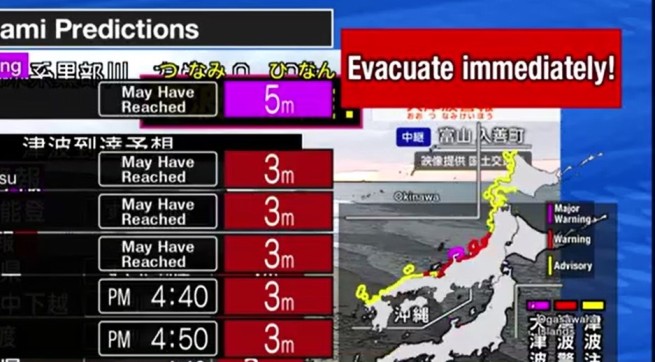Powerful 7.6 Magnitude Earthquake hits Japan, Triggers Tsunami Warnings and Immediate Evacuations
On New Year Day, a massive earthquake of 7.6 magnitude struck Ishikawa Prefecture in central Japan. Tsunami warnings were also issued for Niigata, Toyama, Yamagata, Fukui and Hyogo prefectures, also along the Japan Sea Coast.
TOKYO: Japan experienced a powerful earthquake on Monday, registering a magnitude of 7 on the country’s shindo scale, the highest rating. The quake struck near Ishikawa Prefecture’s Noto Peninsula at approximately 4:10 p.m., leading to tsunami warnings along the entire western coast of Japan. Following the strongest tremor, a magnitude 7.6 quake, tsunami waves had already reached some areas. Reports indicated at least six people trapped in collapsed buildings, with numerous houses collapsing in parts of Ishikawa. Approximately 32,500 homes in the prefecture lost power.
Wajima in Ishikawa witnessed a large-scale fire, further intensifying the crisis. While injury figures were not immediately available, several people were reported to have been taken to hospitals in affected areas.
A major tsunami warning, the highest level of alert, was issued for Ishikawa Prefecture’s Noto Peninsula, with the weather agency cautioning about waves reaching up to 5 meters in the region. Other areas along the Sea of Japan coast, spanning from Hokkaido to Nagasaki, were under tsunami warnings or advisories, predicting waves of up to 3 meters.
The tsunami warning urged residents in Ishikawa, Niigata, Toyama, and Yamagata prefectures to evacuate coastal areas promptly. Waves exceeding 1.2 meters reached the Noto Peninsula’s Wajima Port at around 4:21 p.m. NHK warned that waves might have been higher in specific locations.
This major tsunami warning marked the first of its kind since the devastating March 2011 Great East Japan Earthquake, as confirmed by the Meteorological Agency. The agency also warned that areas experiencing strong shaking could witness quakes of up to shindo 7 in the coming week, particularly in the next two to three days.
Prime Minister Fumio Kishida urged residents in affected areas to stay vigilant against potential aftershocks and tsunamis. The warnings were accompanied by several aftershocks across the Noto Peninsula.
As of 5:30 p.m., the Meteorological Agency recorded 19 tremors measuring shindo 1 or higher, including the shindo 7 main shock and five strong 5 tremors. Waves of 80 cm reached Toyama Prefecture at around 4:35 p.m., with 40 cm waves reported in Kashiwazaki, Niigata Prefecture, at 4:36 p.m. Other regions, including Kanazawa Port, Yamagata Prefecture, and Niigata’s Sado Island, also reported tsunami waves.
The tsunami was expected to reach various prefectures on the Sea of Japan side, including Fukui, Hyogo, Hokkaido, Aomori, Akita, Kyoto, Tottori, and the Oki Islands in Shimane Prefecture.
Chief Cabinet Secretary Yoshimasa Hayashi reported no abnormalities in nuclear power plants across Japan, with ongoing assessments of human and physical damage. Tepco confirmed no impact on its Fukushima nuclear power stations and continued checks on the Kashiwazaki-Kariwa Nuclear Power Plant.
The earthquake, felt in Tokyo and the Kanto area, matched the magnitude of the 1983 Sea of Japan earthquake, which resulted in 104 deaths and 324 injuries. Residents and authorities remain on high alert as the situation unfolds.


